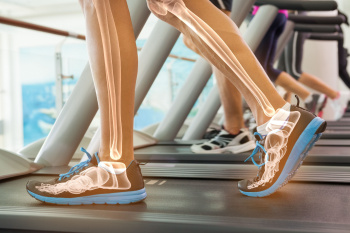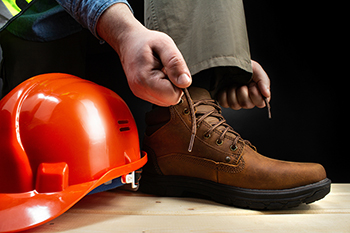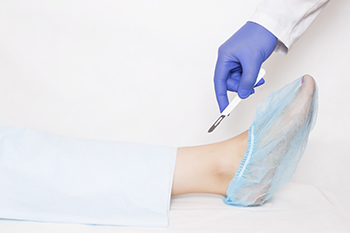Items filtered by date: March 2024
The Functionality of Foot Arches

The biomechanics of the human foot comprises three primary arches, which are the medial longitudinal arch, the lateral longitudinal arch, and the transverse arch. These arches, constructed of bones, ligaments, and tendons, play a vital role in providing support, stability, and shock absorption during weight-bearing activities. The medial longitudinal arch, running along the inner edge of the foot, acts as a natural spring, absorbing the impact of each step and distributing the body's weight evenly. Its counterpart, the lateral longitudinal arch, assists in maintaining balance and stability by bearing weight on the outer edge of the foot. The transverse arch, situated across the midfoot, adds further structural integrity to the foot and facilitates weight transfer during movement. Together, these arches work harmoniously to adapt to various surfaces, absorb shocks, and propel the body forward efficiently. If you are interested in learning more about how the arches of the foot work in harmony with the bones, ligaments, and muscles, it is suggested that you confer with a podiatrist who can provide you with interesting information.
If you have any concerns about your feet, contact the foot specialists from Spartan Podiatry. Our doctors can provide the care you need to keep you pain-free and on your feet.
Biomechanics in Podiatry
Podiatric biomechanics is a particular sector of specialty podiatry with licensed practitioners who are trained to diagnose and treat conditions affecting the foot, ankle and lower leg. Biomechanics deals with the forces that act against the body, causing an interference with the biological structures. It focuses on the movement of the ankle, the foot and the forces that interact with them.
A History of Biomechanics
- Biomechanics dates back to the BC era in Egypt where evidence of professional foot care has been recorded.
- In 1974, biomechanics gained a higher profile from the studies of Merton Root, who claimed that by changing or controlling the forces between the ankle and the foot, corrections or conditions could be implemented to gain strength and coordination in the area.
Modern technological improvements are based on past theories and therapeutic processes that provide a better understanding of podiatric concepts for biomechanics. Computers can provide accurate information about the forces and patterns of the feet and lower legs.
Understanding biomechanics of the feet can help improve and eliminate pain, stopping further stress to the foot.
If you have any questions please feel free to contact our offices located in Battle Creek, and Marshall, MI . We offer the newest diagnostic and treatment technologies for all your foot and ankle needs.
Are You Suffering From Ingrown Toenails?
Foot Protection in Construction Environments

Construction sites are bustling hubs of activity, where safety should always be first and foremost. Among the many precautions taken, ensuring adequate foot protection stands as a cornerstone of construction site safety protocols. Heavy materials, sharp objects, and unpredictable terrain pose constant threats to the feet of workers. To mitigate these risks, wearing sturdy footwear is essential. Boots with reinforced toes and soles provide an essential barrier against falling objects and punctures from nails or debris. Additionally, non-slip soles offer stability on slippery surfaces, reducing the likelihood of slips and falls, which can lead to serious injuries. Wearing footwear that fits properly is equally important. Ill-fitting boots can cause discomfort, blisters, and fatigue. Regular inspection of footwear for signs of wear and tear is also necessary to ensure continued protection. It is suggested that you consult a podiatrist to help with foot problems related to working in construction environments.
While working on the feet, it is important to take the proper care of them. For more information about working on your feet, contact the foot specialists from Spartan Podiatry. Our doctors will treat your foot and ankle needs.
Working on Your Feet
Standing on your feet for long periods of time can cause stress and pain in your feet. Your whole body may experience change in terms of posture, back pain, bunions, callouses and or plantar warts. There are ways to avoid these conditions with proper foot care, smart choices and correct posture.
Positive Changes
Negative heeled shoe – Choosing this shoe type places the heel slightly lower than the ball of the foot. These are great for overall foot health. Find shoes that fit you correctly.
Go barefoot – Our feet were not designed to be enclosed for all hours of the day. Try to periodically expose your feet to air.
Eliminate Pain
Foot Exercises – Performing simple exercises, incorporating yoga and doing stretches are beneficial. This will allow increased blood flow to the area and muscles of the foot.
Achilles tendon – Stretching the foot out flat on the floor will relax the calf muscles and tendon. These exercises can be performed almost anywhere. Make sure you add these exercises to your daily regimen.
With a little bit of this information and knowing more about foot health, you will notice changes. Foot stretches and proper footwear will help with pain and prevent further issues.
If you have any questions please feel free to contact our offices located in Battle Creek, and Marshall, MI . We offer the newest diagnostic and treatment technologies for all your foot and ankle needs.
Recovering From Ankle Replacement Surgery

Total ankle replacement, also known as total ankle arthroplasty, is a significant surgery aimed at relieving ankle pain. During the procedure, the surgeon removes parts of the shin bone, or tibia, and the top portion of the foot's highest bone, the talus, replacing the ankle with plastic or metal components. After surgery, you will likely have a cast, boot, or splint on your leg for approximately a month, and you will not be able to put weight on it immediately. You may need crutches, a walker, or a knee scooter during this time. It is important to have assistance at home during the initial recovery period. You will be discharged with bandages and stitches or staples, which your doctor will advise you on when to remove. Post-surgery, you may experience mild pain and swelling, for which your doctor may prescribe medication. Rehabilitation exercises, which are important for regaining strength and mobility, will continue for several weeks. Returning to work depends on individual recovery speed and job requirements, with certain movements or weight-bearing activities possibly restricted. If you have had your ankle replaced, it is suggested that you are under the care of a podiatrist who will provide personalized recovery steps for the most successful outcome.
In certain cases, in which the patient suffers from extreme pain or damage in a joint, joint replacement surgery may be deemed useful. If you have constant pain in a foot joint, consult with the foot specialists from Spartan Podiatry. Our doctors will assess your condition and provide you with quality foot and ankle treatment.
What Is Joint Replacement Surgery?
Over time, joints wear down; this can be exacerbated by diseases and conditions. Joint replacement surgery, also known as arthroplasty, is when a damaged joint is surgically removed and replaced with a prosthesis. Prostheses, which can be made of ceramic, plastic, or metal, act as joints in lieu of an actual joint. One of the most prevalent causes for joint replacement is arthritis.
Arthritis in the Foot
Arthritis can occur in any joint in the body, including in the feet. Common types of arthritis in the foot are osteoarthritis, rheumatoid arthritis, and gout. The big toe is usually where arthritis occurs in the foot; this is known as hallux rigidus.
Joint Replacement Surgery in the Foot
The most common form of joint replacement in the foot is a first metatarsophalangeal (MTP) joint placement. MTP joint replacement surgery is designed to treat hallux rigidus. Surgery is not intensive, and recovery occurs within one to two months after the procedure has been done. Overall, joint replacement surgery is a safe and effective way to treat pain in the joint of the foot.
If you have any questions, please feel free to contact our offices located in Battle Creek, and Marshall, MI . We offer the newest diagnostic and treatment technologies for all your foot care needs.
Causes of Corns on the Feet

Corns, also known as helomas, are a common foot condition characterized by thickened, hardened areas of skin that develop in response to friction or pressure. These small, round, or conical lesions typically form on the toes, sides of the feet, or on weight-bearing areas. Corns result from repetitive rubbing or friction against footwear or adjacent toes, leading to the accumulation of dead skin cells. Wearing ill-fitting shoes, high heels, or tight socks, or having foot deformities such as hammertoes or bunions can increase the risk of corn formation. Additionally, activities that involve prolonged standing or walking contribute to increased pressure on the feet, further predisposing individuals to corns. Poor foot hygiene and inadequate moisture control may also contribute to corn development. While corns are generally harmless, they can cause discomfort, pain, and difficulty wearing shoes. If you have developed a corn on your foot, it is suggested that you visit a podiatrist who can offer you effective treatment methods.
Corns can make walking very painful and should be treated immediately. If you have questions regarding your feet and ankles, contact the foot specialists of Spartan Podiatry. Our doctors will treat your foot and ankle needs.
Corns: What Are They? And How Do You Get Rid of Them?
Corns are thickened areas on the skin that can become painful. They are caused by excessive pressure and friction on the skin. Corns press into the deeper layers of the skin and are usually round in shape.
Ways to Prevent Corns
There are many ways to get rid of painful corns such as:
- Wearing properly fitting shoes that have been measured by a professional
- Wearing shoes that are not sharply pointed or have high heels
- Wearing only shoes that offer support
Treating Corns
Although most corns slowly disappear when the friction or pressure stops, this isn’t always the case. Consult with your podiatrist to determine the best treatment option for your case of corns.
If you have any questions please feel free to contact our offices located in Battle Creek, and Marshall, MI . We offer the newest diagnostic and treatment technologies for all your foot and ankle needs.

